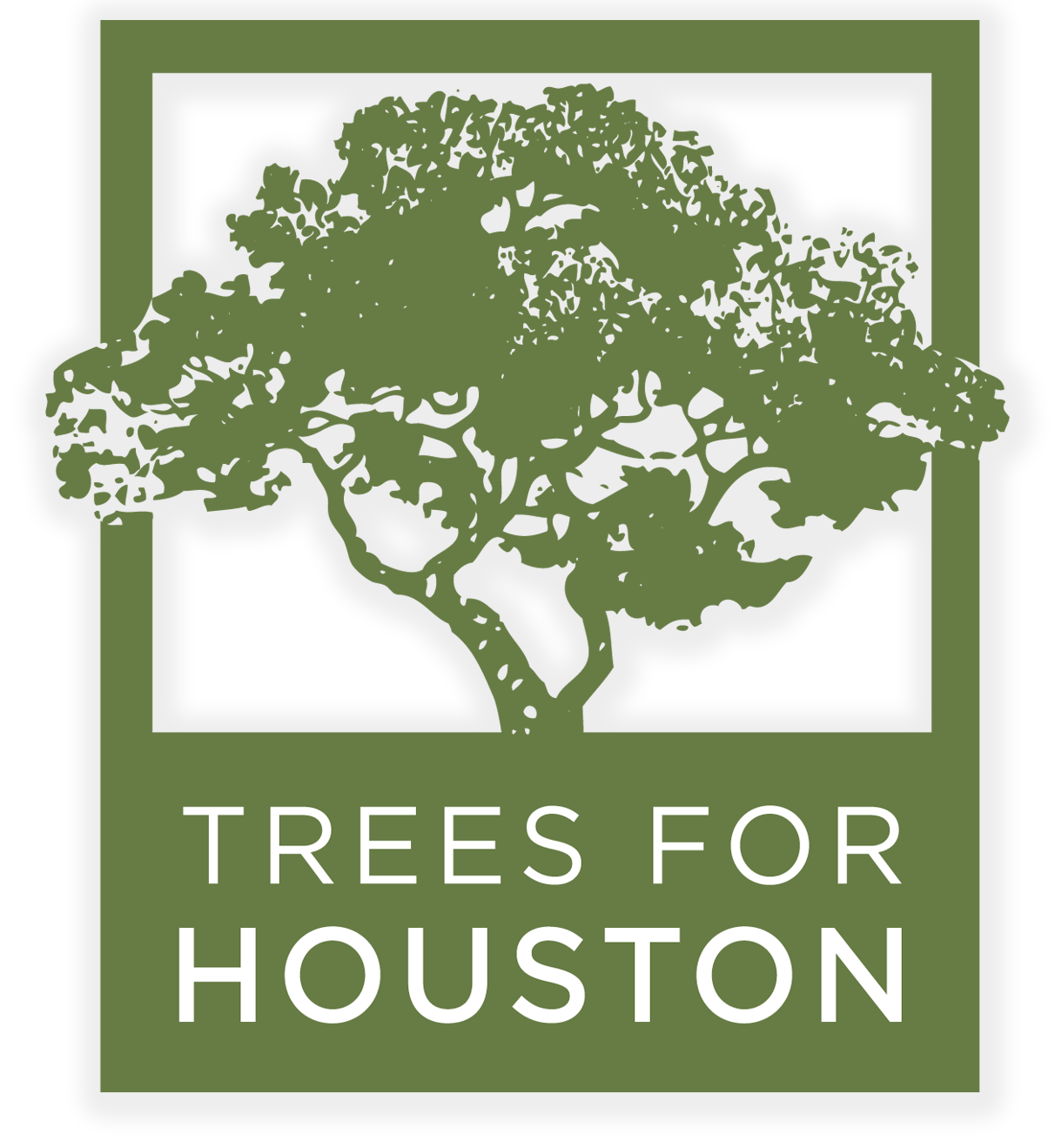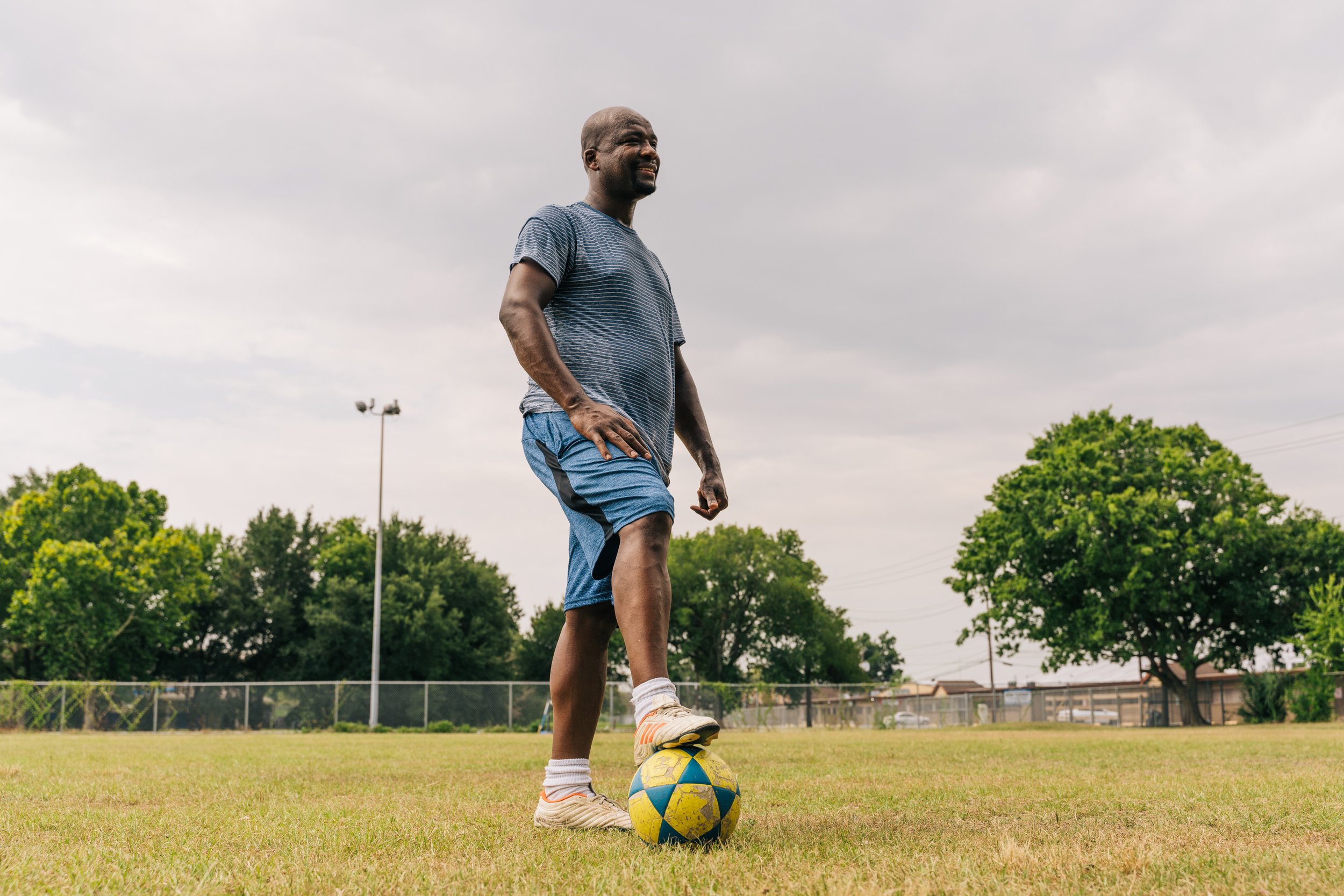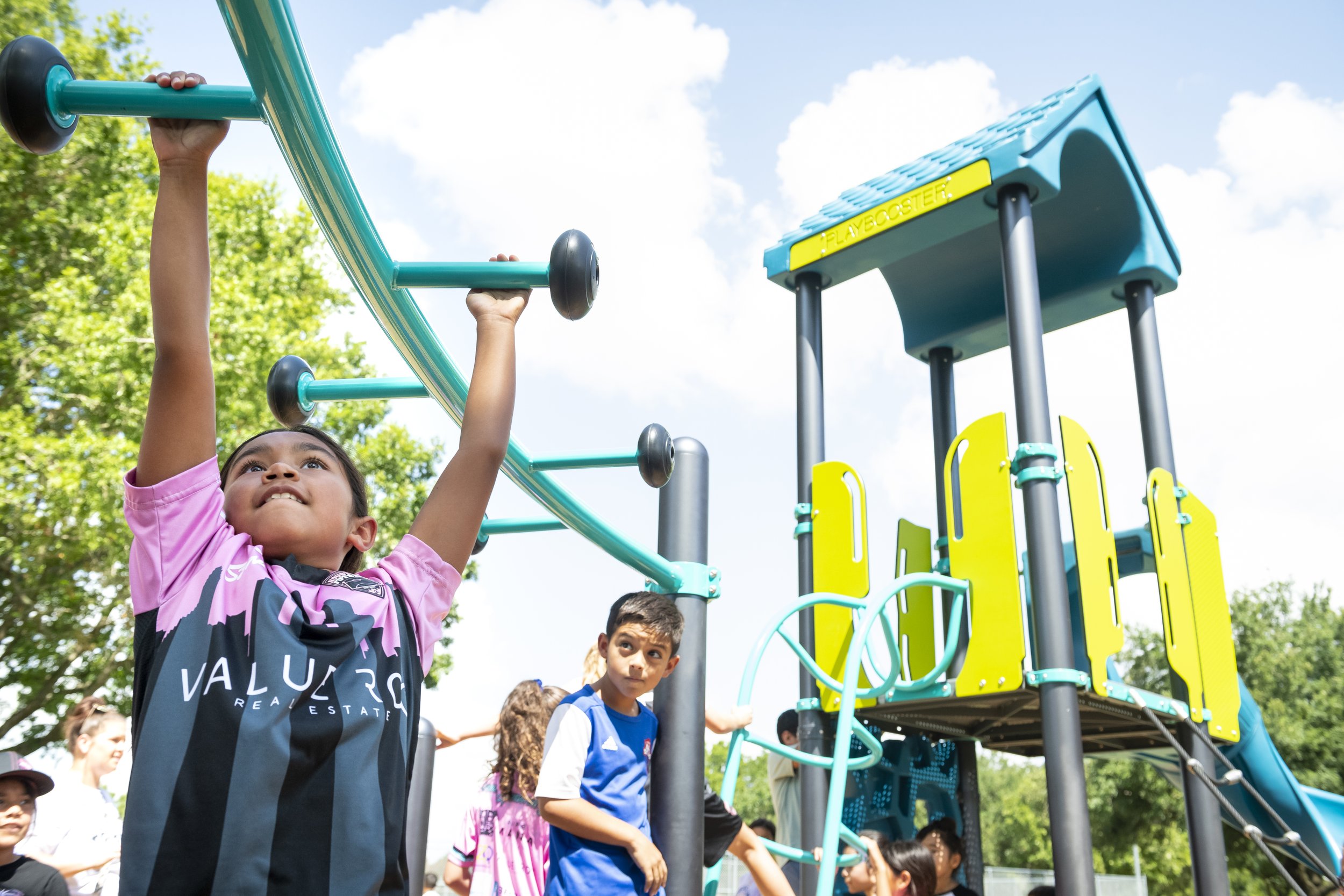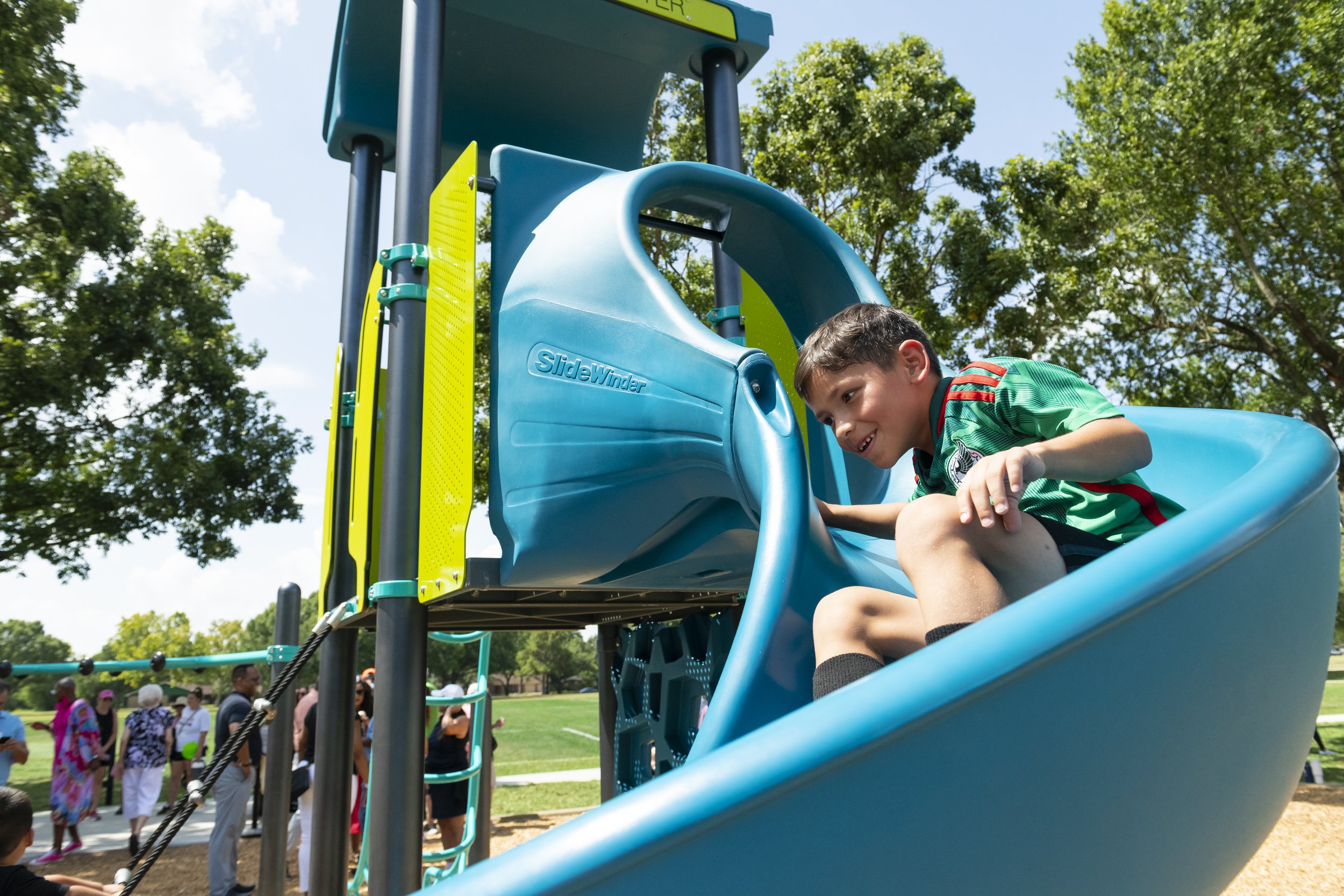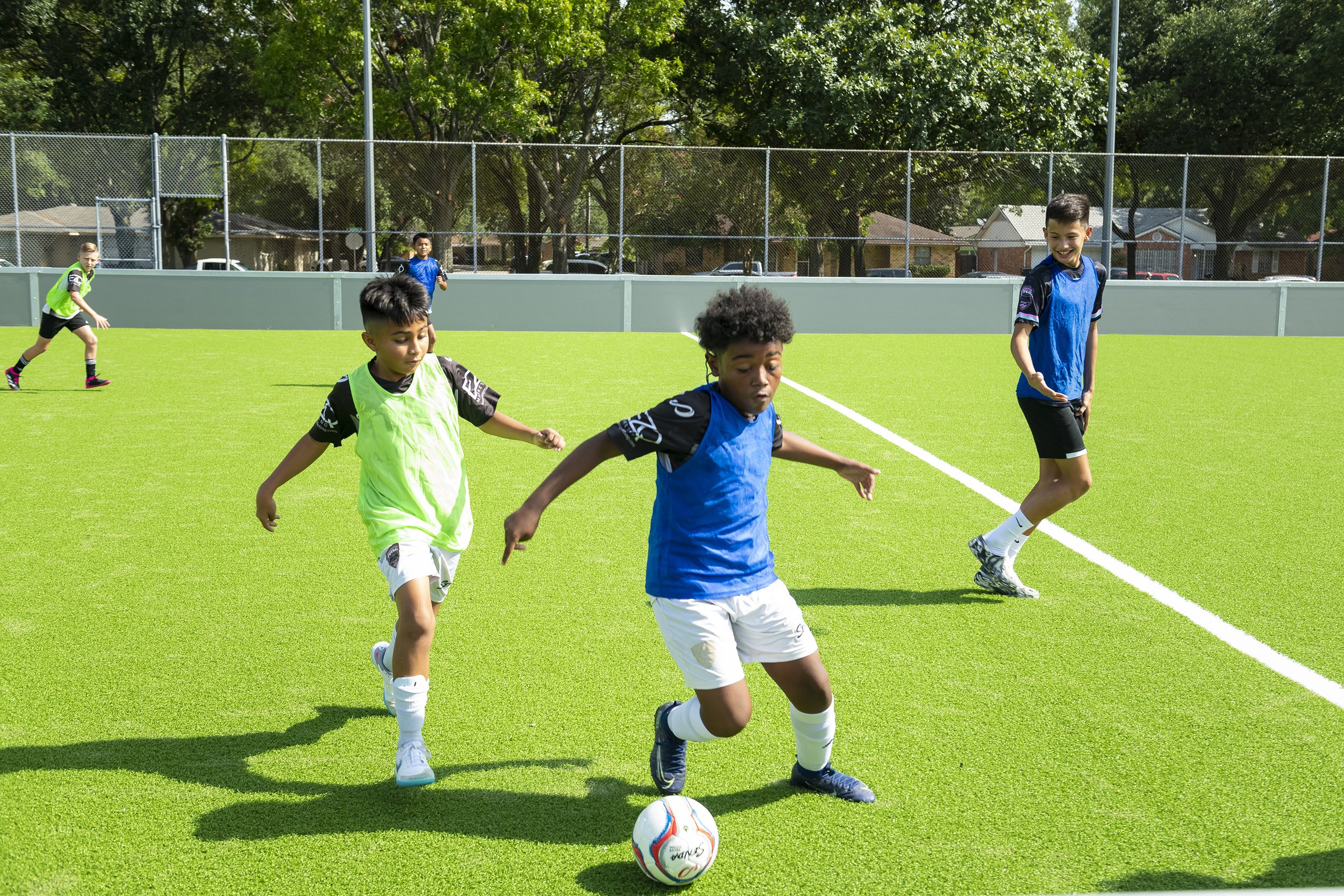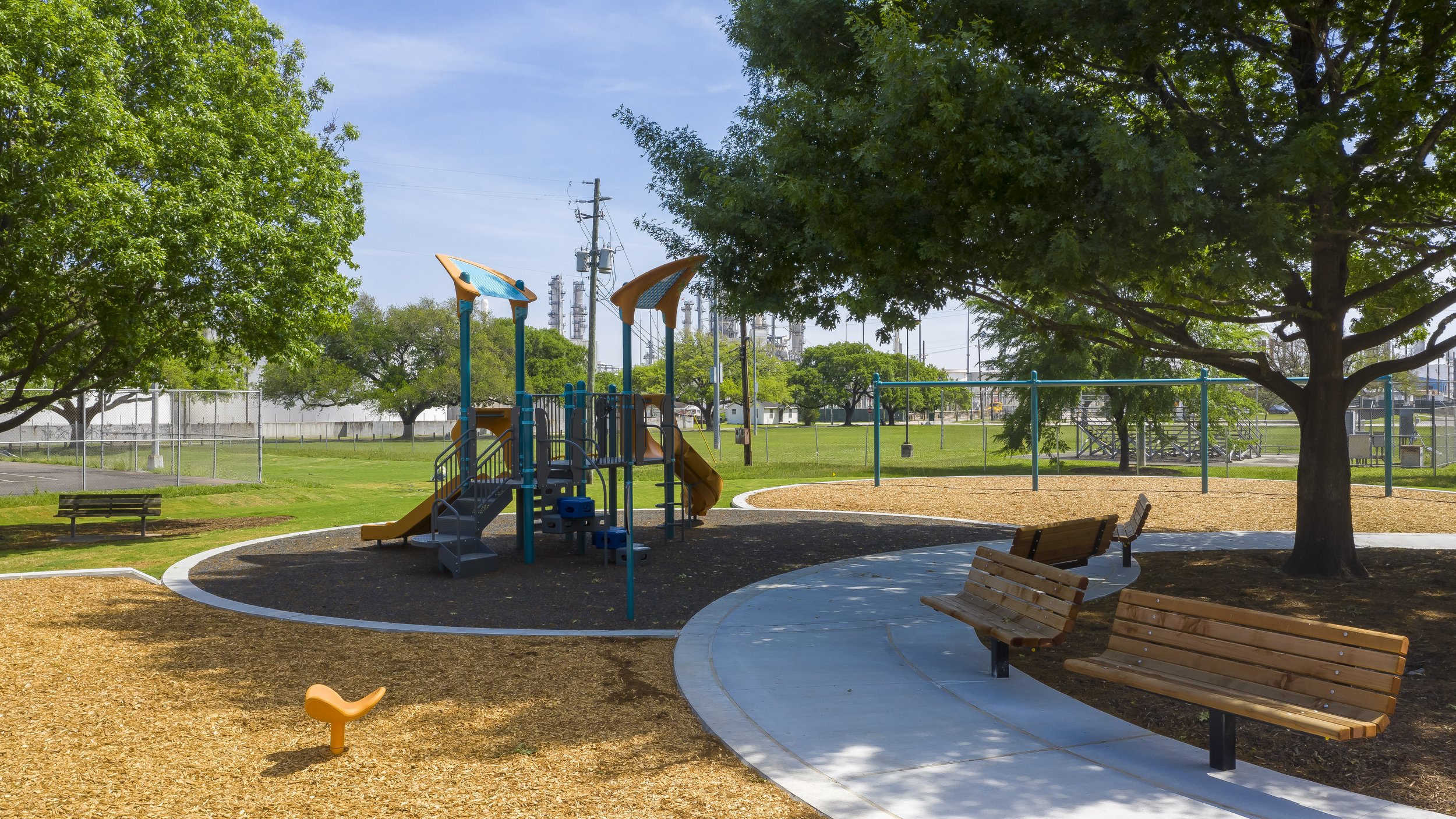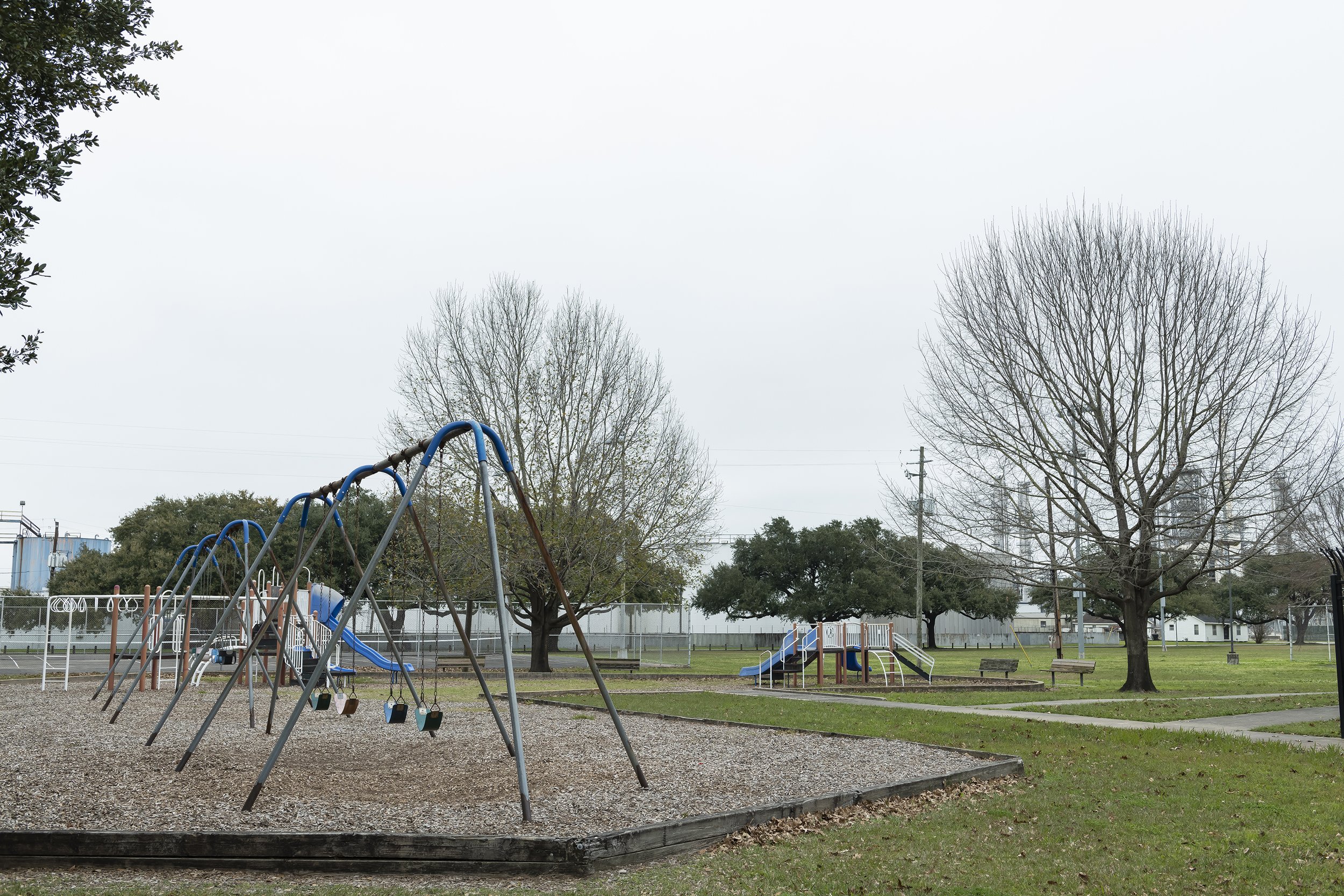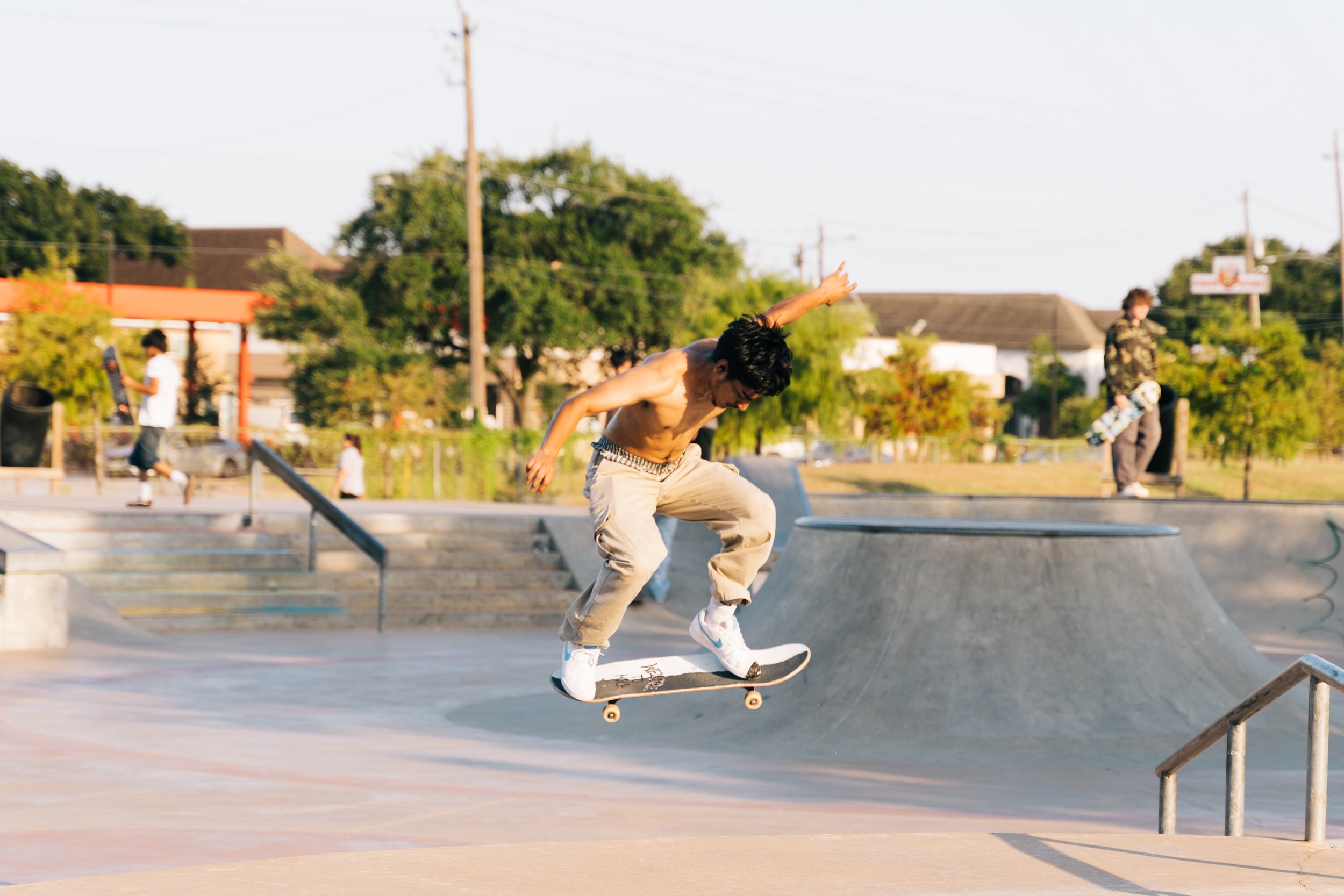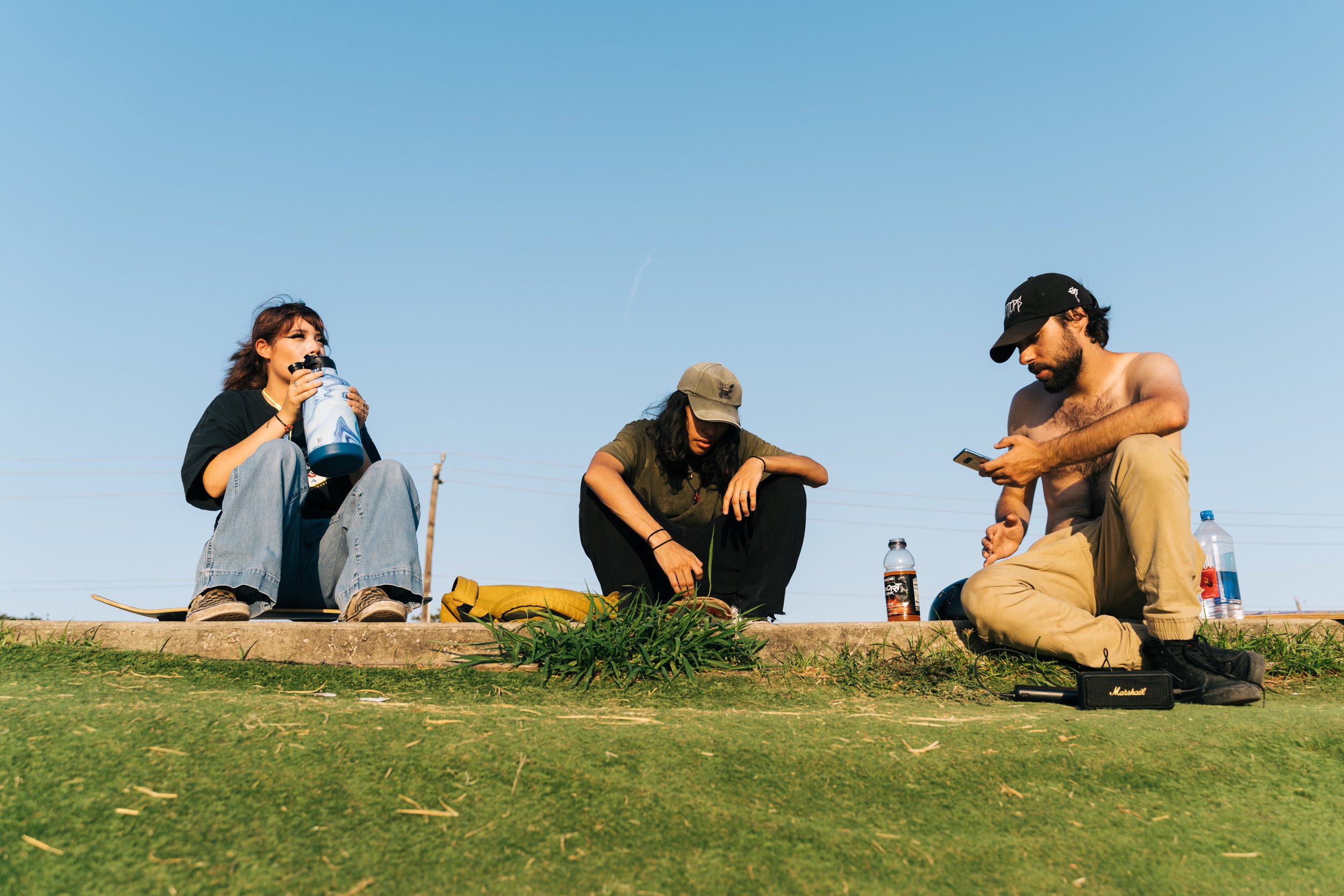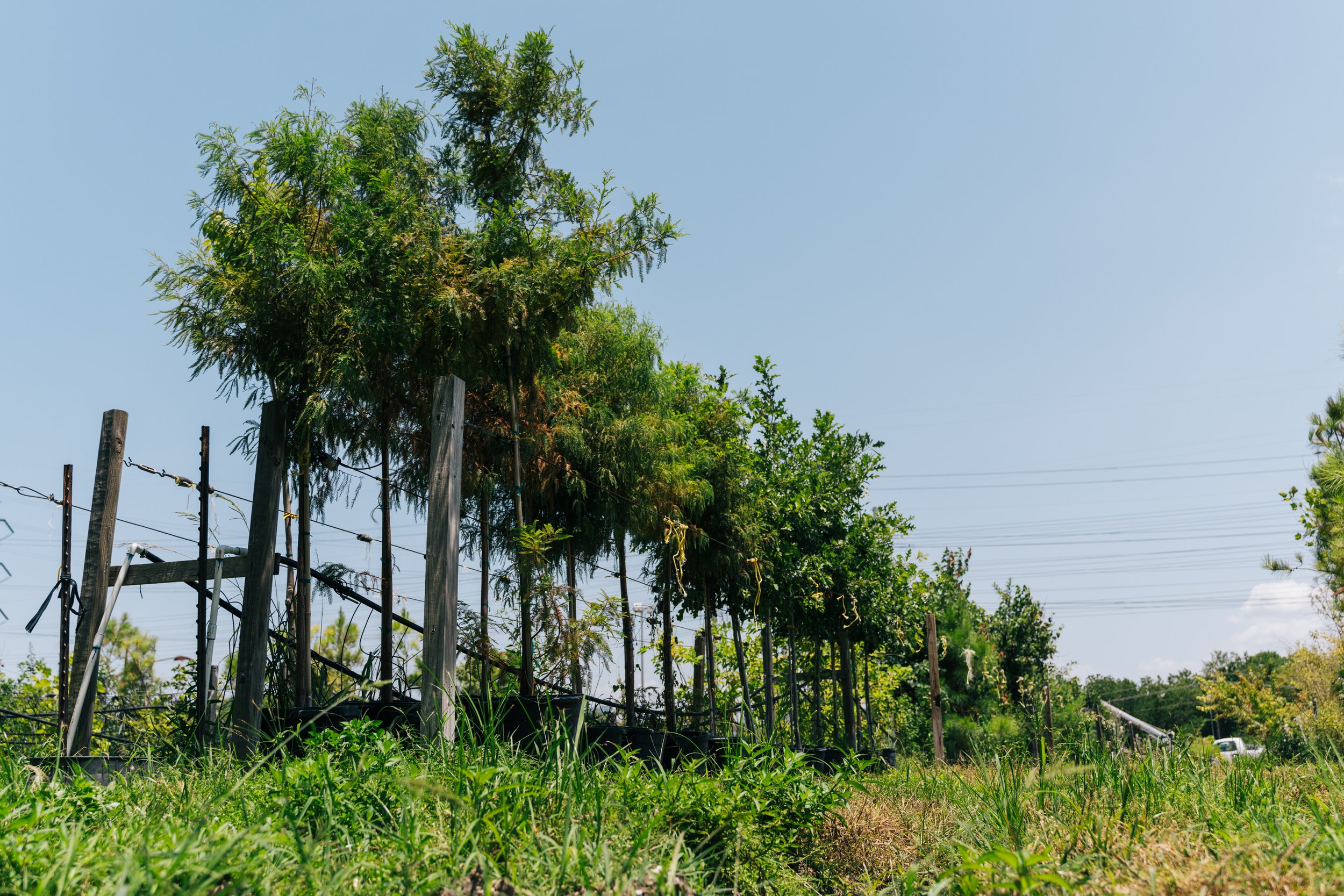Desta Debancho plays soccer at Gulfton’s Burnett Bayland Park on Tuesday, Aug.1, 2023. “Green is good for everyone,” Debancho said about the millions of dollars committed by Houston Endowment to make the neighborhood greener. (Photo by Joseph Bui for Houston Endowment)
‘Green is Good for Everyone’
Houston Endowment gives $8 million to Houston Parks Board and Trees For Houston to increase access to great neighborhood parks and build tree canopy in areas where the urban “heat island” effect is most pronounced.
By Mike Snyder
HoustonEndowment.org contributor
The children waited patiently through the standard rituals of a ribbon-cutting ceremony: speeches by public officials and civic leaders, thank-yous followed by more thank-yous, hugs and handshakes and air kisses. They sat cross-legged, utterly silent, on the concrete floor of the pavilion at Dow Park near Hobby Airport. A little boy of about 3 colored on a page labeled, “Who Uses Trails?”
After the speeches, dozens of children and grown-ups walked across a patch of newly planted sod, the spaces between the green squares still visible. They passed teenagers playing soccer on a new pitch and adults playing pickleball on a new court. They stopped in front of the playground and watched dignitaries cut the ribbon marking the “reopening” of this park, originally developed in the 1950s and described by Mayor Sylvester Turner as “the heart of the community.”
Then, finally, came the most important part of the July 29 event: The kids rushed past the dignitaries and began climbing and jumping and swinging on the shiny new playground equipment that was part of the park’s $1.25 million refurbishment, which also included improvements to trails, lighting, and sports facilities.
Children play at the newly renovated Dow Park, a project of the “50/50” Park Partners program, a public-private partnership to upgrade neighborhood parks. (Photos courtesy of Houston Parks Board)
Across the Houston area, residents of many neighborhoods lack convenient access to parks with the kinds of amenities the children at Dow Park were enjoying — or to parks, trees, and greenspace generally. “Park equity” is a key goal of the “50/50” Park Partners program, a Turner-led coalition of public and private partners, including Houston Parks Board, that paid for the Dow Park improvements and plans to upgrade 22 neighborhood parks this year, according to Barron Wallace, the Houston Parks Board chairman.
Now the Houston Parks Board and another longtime Houston nonprofit with a related mission, Trees For Houston, have an important new source of funding to ramp up their efforts to increase access to quality parks and the tree cover needed to address Houston’s intense “urban heat island” effect. Houston Endowment is giving each organization $4 million grants over two years to help achieve these goals.
“We need to keep pushing for park equity and invest in communities where it’s really needed,” said Beth White, the Houston Parks Board’s president and CEO.
A new pickleball court and soccer pitch are part of the improvements at Dow Park. (Photos courtesy of Houston Parks Board)
Bao Long-Chu, Houston Endowment’s program director for arts and parks, said the grants build upon a previous strategy that invested nearly $65 million in “signature parks” such as Buffalo Bayou Park and the Bayou Greenways initiative, which connects citywide trails alongside Houston’s bayous. “Now we want to pay attention to other greenspaces,” Chu said. “We thought about these two entities and determined they could enact larger thinking about park equity, especially paying attention to neighborhoods that don’t have easy access to great parks and greenspaces.”
The dollars are meant to supercharge the organizations’ work and ensure they can move quickly on upcoming projects, said Lisa Hall, vice president of program strategy at Houston Endowment.
Hartman Park is seen before (left) and after renovation by the 50/50 program, which considers safety, amenities, tree shade, and accessibility, among other factors. (Photo courtesy of Houston Parks Board)
Urban ‘Heat Islands’
Houston ranks fourth among U.S. cities with the most intense urban heat islands, according to an analysis by the independent research group Climate Central. Gulfton was identified as the hottest neighborhood in Houston — 17 degrees warmer than the coolest area — in a 2020 heat-mapping study conducted by the Nature Conservancy in Texas. Gulfton also has less tree cover than other parts of Houston: 4% shade and an average surface temperature of 91 degrees, according to data from the Tree Equity Score, an initiative of American Forests. West University Place, a much wealthier community just five miles to the east, has 38% shade and an average temperature of 83 degrees.
In Gulfton’s Burnett Bayland Park, the temperature was 91 degrees on a recent morning, headed for a forecast high of 100. Sweat poured off the face of Desta Debancho, a 45-year-old truck driver, as he practiced his soccer moves in a section of the park where no trees provide shade. Debancho, an immigrant from Ethiopia, lives in a nearby apartment complex, and he was encouraged to learn that millions of dollars had been committed to making the neighborhood greener.
“It will bring more shade and help with climate change,” said Debancho. “Green is good for everyone.”
Barry Ward, executive director of Trees For Houston, plants a tree during an Arbor Day celebration in January 2023. Trees for Houston plans to plant hundreds of shade trees in the Gulfton area to fight the urban “heat island” effect. (Photo courtesy of Trees For Houston)
Barry Ward, Trees For Houston’s executive director, said that even before learning about the Houston Endowment gift, the organization was committed to planting hundreds of street trees in Gulfton. Now, he said, they will have the resources to make it happen. Ward noted that costs are not limited to purchasing and planting trees — they must be watered and pruned, especially in the early years after planting. The Foundation’s gift will enable him to set aside funds for maintenance, he said.
As Ward drove around Gulfton and other southwest Houston neighborhoods, he pointed out spots where his organization had planted trees and other sites where trees were planted in rights-of-way too narrow for them to thrive. When he passed wide swaths of green space with no trees between the sidewalk and the street, he chafed at the missed opportunities. An inexpertly pruned magnolia tree outside an apartment complex “will be dead in a year,” he said.
Ward pointed out an “urban heat island” on West Bellfort — a blocks-long concentration of retail strip centers and apartment blocks, with nary a tree in sight. “Look at that,” he said. “These people have no shade.” The apartment owners would save more on power bills than it would cost them to plant some shade trees, he said.
Children run through sprays of water at Burnett Bayland Park in Gulfton during the evening on Tuesday, Aug. 1, 2023. The park has been identified by Trees for Houston as a place to plant new trees. (Photo by Joseph Bui for Houston Endowment)
Skateboarders flock to Burnett Bayland Park in Gulfton during the evening when the temperature is cooler on Tuesday, Aug. 1, 2023. (Photos by Joseph Bui for Houston Endowment)
‘Do You Have Access to Wonder?’
Many such heat islands exist in Gulfton, but a recent study by the Texas A&M Forest Service and the Nature Conservancy in Texas identified sites for more than 500 additional trees in the neighborhood.
Jaime González, the community and equitable conservation programs director for the Nature Conservancy in Texas, said the difference in average temperatures between Gulfton and other neighborhoods is “stupefying.” In addition to Gulfton, access to parks and green space is scarce in Alief, parts of Aldine and other neighborhoods, he said. “What we’re seeing is heat building up in those areas to dangerous levels,” González said.
Pedestrians cross Gulfton Street in direct sunlight on Tuesday, Aug. 1, 2023, in Houston. (Photo by Joseph Bui for Houston Endowment)
Gulfton is one of the most transit-dependent neighborhoods in Houston, and many bus stops consist of nothing more than a sign stuck in the ground with no trees or shelters for shade. The pavement temperature under an uncovered bus stop can reach 135 degrees, González said.
González said his organization also is focused on “biodiversity equity.” Even neighborhoods where trees seem abundant may lack pollinators — foliage that attracts bees and birds, González said. This leads to inequities beyond the obvious recreational and cooling benefits of greenspace: “Do you have a chance to see a monarch (butterfly)? Do you have a chance to hear birds? Do you have access to wonder?”
Particularly of concern for Houston, increased greenspace and tree canopy also help to prevent heat-related deaths and illnesses, reduce pollution, and mitigate stormwater runoff, according to American Forests.
(Left) Trees seen along South Post Oak Road Tuesday, Aug. 1, 2023 were planted by Trees For Houston. (Photo by Joseph Bui for Houston Endowment). (Right) Trees stand ready for planting at Trees For Houston’s nursery in Bellaire on Tuesday, Aug. 1, 2023, in Houston. (Photo by Joseph Bui for Houston Endowment)
The Foundation’s park grants, Chu said, come at an opportune time: Harris County voters last November approved about $200 million for park construction and maintenance, and the Biden administration has approved $1 billion in funding to increase access to greenspaces in neighborhoods across the country. Ward, of Trees For Houston, anticipates using a portion of the Houston Endowment gift as matching dollars to help bring some of those federal funds to Houston and work with the Student Conservation Association on its plan to plant trees in city parks.
“The timing was right,” Chu said, “in the sense of, we knew that our investment could spark additional conversation to bring attention to these issues and has the potential to attract additional funds.”
